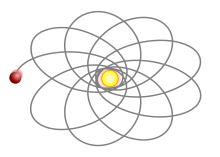Rosetta orbit
In astronomy, a Rosetta orbit occurs when an object approaching a black hole with an intermediate velocity (not slow enough to spiral into the hole and not fast enough to escape) enters a complex orbit pattern, bounded by a near and far distance to the hole and tracing an oscillating pattern known as a hypotrochoid. In 2020, scientists using observations made by the European Southern Observatory's Very Large Telescope revealed for the first time that star S2 orbits in this pattern around Sagittarius A*.[1][2]

Example of an exaggerated Rosetta orbit
A Rosetta orbit is a complex type of orbit.
In quantum mechanics, the Rosetta orbit is a solution for spherically symmetric (except 1/r) potentials.
References
- "ESO telescope sees star dance around supermassive black hole, proves Einstein right". ScienceDaily. 2020-04-16. Retrieved 2020-05-03.
- Jennifer Leman (2020-04-16). "Weird Black Hole-Orbiting Star Proves Einstein Right (Again)". Popular Mechanics. Retrieved 2020-05-03.
This article is issued from Wikipedia. The text is licensed under Creative Commons - Attribution - Sharealike. Additional terms may apply for the media files.